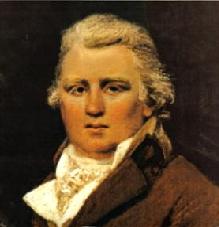The Origin of “Liberty Stump”
In 1796 the British-born, Philadelphia-based bookseller and publisher William Cobbett issued “A History of the American Jacobins, &c.” as an pseudonymous appendix to his edition of William Playfair’s The History of Jacobinism, Its Crimes, Cruelties and Perfidies.
Playfair (1759-1823) was the inventor of the bar graph, the pie chart, and other forms of presenting data that infuse our information culture. He was also a secret agent for the British government during its wars with Revolutionary France. At the same time Playfair wrote that book about Jacobinism, he was trying to collapse the French economy with counterfeit money. But I digress.
In that appendix on “American Jacobins,” Cobbett as “Peter Porcupine” claimed the French Revolution had inspired a fad for renaming places in America to reflect more radical, less royal values. He stated:
“Liberty Stump” was no more and no less than the remains of Liberty Tree, so dubbed by Boston Whig leaders in September 1765. Ten years later, in the summer of 1775, Loyalists and British soldiers chopped down that political landmark. That tree was a large and stately elm, but neither it nor its stump had ever been designated “Royal.”
The term “Liberty Stump” appeared in November 1776 in an advertisement in the Continental Journal. Locals must already have been referring to it by that phrase. Before the end of the war many other Bostonians used the same term in their ads, including the chemist Robert Hewes, the printers Ezekiel Russell and Nathaniel Coverly, the hostess Mary Freeman, and the maltster William Patten.
The last advertisement I found dropping the phrase “Liberty Stump” was in the Columbian Centinel in June 1803. Two years later the Boston Commercial Gazette received a letter signed “Liberty Stump,” but the editors declined to publish its contents as “too personal.”
After that, the phrase disappears from the newspaper database I use until 1824, when Lafayette came through town and stopped to view the half-century-old stump, prompting patriotic nostalgia.
Thus, “Liberty Stump” was in no way an example of American “Jacobins” renaming sites to reflect their new politics. Instead, it was a way Revolutionary Bostonians held onto a homegrown political tradition.
Of course, Liberty Tree had been an example of American “Patriots” renaming sites to reflect their new politics. But Cobbett didn’t object to that example of “re-baptism”—only to examples coming from a political movement he disliked.
TOMORROW: What about “Equality Lane”?
Playfair (1759-1823) was the inventor of the bar graph, the pie chart, and other forms of presenting data that infuse our information culture. He was also a secret agent for the British government during its wars with Revolutionary France. At the same time Playfair wrote that book about Jacobinism, he was trying to collapse the French economy with counterfeit money. But I digress.
In that appendix on “American Jacobins,” Cobbett as “Peter Porcupine” claimed the French Revolution had inspired a fad for renaming places in America to reflect more radical, less royal values. He stated:
The rage for re-baptism, as the French call it, also spread very far. An alley at Boston, called Royal Exchange Alley, and the stump of a tree, in the same town, which had borne the name of Royal, were re-baptized with a vast deal of formality: the former was called Equality Lane, and the latter Liberty Stump.Cobbett had arrived in the U.S. of A. in late 1792 and appears to have known Boston only through newspapers. He was mistaken about the origin of the phrase “Liberty Stump,” which Bostonians used for over a decade before the start of the French Revolution.
“Liberty Stump” was no more and no less than the remains of Liberty Tree, so dubbed by Boston Whig leaders in September 1765. Ten years later, in the summer of 1775, Loyalists and British soldiers chopped down that political landmark. That tree was a large and stately elm, but neither it nor its stump had ever been designated “Royal.”
The term “Liberty Stump” appeared in November 1776 in an advertisement in the Continental Journal. Locals must already have been referring to it by that phrase. Before the end of the war many other Bostonians used the same term in their ads, including the chemist Robert Hewes, the printers Ezekiel Russell and Nathaniel Coverly, the hostess Mary Freeman, and the maltster William Patten.
The last advertisement I found dropping the phrase “Liberty Stump” was in the Columbian Centinel in June 1803. Two years later the Boston Commercial Gazette received a letter signed “Liberty Stump,” but the editors declined to publish its contents as “too personal.”
After that, the phrase disappears from the newspaper database I use until 1824, when Lafayette came through town and stopped to view the half-century-old stump, prompting patriotic nostalgia.
Thus, “Liberty Stump” was in no way an example of American “Jacobins” renaming sites to reflect their new politics. Instead, it was a way Revolutionary Bostonians held onto a homegrown political tradition.
Of course, Liberty Tree had been an example of American “Patriots” renaming sites to reflect their new politics. But Cobbett didn’t object to that example of “re-baptism”—only to examples coming from a political movement he disliked.
TOMORROW: What about “Equality Lane”?


No comments:
Post a Comment